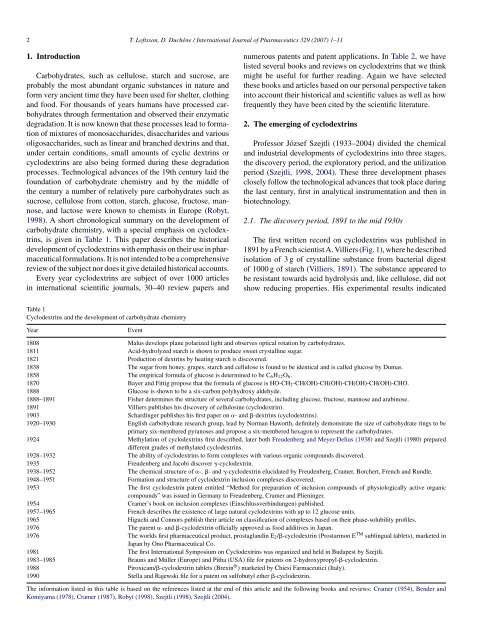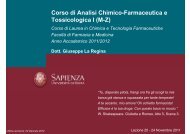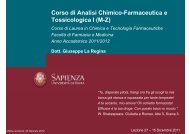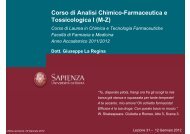Cyclodextrins and their pharmaceutical applications - C.T.F.
Cyclodextrins and their pharmaceutical applications - C.T.F.
Cyclodextrins and their pharmaceutical applications - C.T.F.
Create successful ePaper yourself
Turn your PDF publications into a flip-book with our unique Google optimized e-Paper software.
2 T. Loftsson, D. Duchêne / International Journal of Pharmaceutics 329 (2007) 1–11<br />
1. Introduction<br />
Carbohydrates, such as cellulose, starch <strong>and</strong> sucrose, are<br />
probably the most abundant organic substances in nature <strong>and</strong><br />
form very ancient time they have been used for shelter, clothing<br />
<strong>and</strong> food. For thous<strong>and</strong>s of years humans have processed carbohydrates<br />
through fermentation <strong>and</strong> observed <strong>their</strong> enzymatic<br />
degradation. It is now known that these processes lead to formation<br />
of mixtures of monosaccharides, disaccharides <strong>and</strong> various<br />
oligosaccharides, such as linear <strong>and</strong> branched dextrins <strong>and</strong> that,<br />
under certain conditions, small amounts of cyclic dextrins or<br />
cyclodextrins are also being formed during these degradation<br />
processes. Technological advances of the 19th century laid the<br />
foundation of carbohydrate chemistry <strong>and</strong> by the middle of<br />
the century a number of relatively pure carbohydrates such as<br />
sucrose, cellulose from cotton, starch, glucose, fructose, mannose,<br />
<strong>and</strong> lactose were known to chemists in Europe (Robyt,<br />
1998). A short chronological summary on the development of<br />
carbohydrate chemistry, with a special emphasis on cyclodextrins,<br />
is given in Table 1. This paper describes the historical<br />
development of cyclodextrins with emphasis on <strong>their</strong> use in <strong>pharmaceutical</strong><br />
formulations. It is not intended to be a comprehensive<br />
review of the subject nor does it give detailed historical accounts.<br />
Every year cyclodextrins are subject of over 1000 articles<br />
in international scientific journals, 30–40 review papers <strong>and</strong><br />
Table 1<br />
<strong>Cyclodextrins</strong> <strong>and</strong> the development of carbohydrate chemistry<br />
Year Event<br />
numerous patents <strong>and</strong> patent <strong>applications</strong>. In Table 2, wehave<br />
listed several books <strong>and</strong> reviews on cyclodextrins that we think<br />
might be useful for further reading. Again we have selected<br />
these books <strong>and</strong> articles based on our personal perspective taken<br />
into account <strong>their</strong> historical <strong>and</strong> scientific values as well as how<br />
frequently they have been cited by the scientific literature.<br />
2. The emerging of cyclodextrins<br />
Professor József Szejtli (1933–2004) divided the chemical<br />
<strong>and</strong> industrial developments of cyclodextrins into three stages,<br />
the discovery period, the exploratory period, <strong>and</strong> the utilization<br />
period (Szejtli, 1998, 2004). These three development phases<br />
closely follow the technological advances that took place during<br />
the last century, first in analytical instrumentation <strong>and</strong> then in<br />
biotechnology.<br />
2.1. The discovery period, 1891 to the mid 1930s<br />
The first written record on cyclodextrins was published in<br />
1891 by a French scientist A. Villiers (Fig. 1), where he described<br />
isolation of 3 g of crystalline substance from bacterial digest<br />
of 1000 g of starch (Villiers, 1891). The substance appeared to<br />
be resistant towards acid hydrolysis <strong>and</strong>, like cellulose, did not<br />
show reducing properties. His experimental results indicated<br />
1808 Malus develops plane polarized light <strong>and</strong> observes optical rotation by carbohydrates.<br />
1811 Acid-hydrolyzed starch is shown to produce sweet crystalline sugar.<br />
1821 Production of dextrins by heating starch is discovered.<br />
1838 The sugar from honey, grapes, starch <strong>and</strong> cellulose is found to be identical <strong>and</strong> is called glucose by Dumas.<br />
1858 The empirical formula of glucose is determined to be C6H12O6.<br />
1870 Bayer <strong>and</strong> Fittig propose that the formula of glucose is HO-CH2-CH(OH)-CH(OH)-CH(OH)-CH(OH)-CHO.<br />
1888 Glucose is shown to be a six-carbon polyhydroxy aldehyde.<br />
1888–1891 Fisher determines the structure of several carbohydrates, including glucose, fructose, mannose <strong>and</strong> arabinose.<br />
1891 Villiers publishes his discovery of cellulosine (cyclodextrin).<br />
1903 Schardinger publishes his first paper on �- <strong>and</strong> �-dextrins (cyclodextrins).<br />
1920–1930 English carbohydrate research group, lead by Norman Haworth, definitely demonstrate the size of carbohydrate rings to be<br />
primary six-membered pyranoses <strong>and</strong> propose a six-membered hexagon to represent the carbohydrates.<br />
1924 Methylation of cyclodextrins first described, later both Freudenberg <strong>and</strong> Meyer-Delius (1938) <strong>and</strong> Szejtli (1980) prepared<br />
different grades of methylated cyclodextrins.<br />
1928–1932 The ability of cyclodextrins to form complexes with various organic compounds discovered.<br />
1935 Freudenberg <strong>and</strong> Jacobi discover �-cyclodextrin.<br />
1938–1952 The chemical structure of �-, �- <strong>and</strong> �-cyclodextrin elucidated by Freudenberg, Cramer, Borchert, French <strong>and</strong> Rundle.<br />
1948–1951 Formation <strong>and</strong> structure of cyclodextrin inclusion complexes discovered.<br />
1953 The first cyclodextrin patent entitled “Method for preparation of inclusion compounds of physiologically active organic<br />
compounds” was issued in Germany to Freudenberg, Cramer <strong>and</strong> Plieninger.<br />
1954 Cramer’s book on inclusion complexes (Einschlussverbindungen) published.<br />
1957–1965 French describes the existence of large natural cyclodextrins with up to 12 glucose units.<br />
1965 Higuchi <strong>and</strong> Connors publish <strong>their</strong> article on classification of complexes based on <strong>their</strong> phase-solubility profiles.<br />
1976 The parent �- <strong>and</strong> �-cyclodextrin officially approved as food additives in Japan.<br />
1976 The worlds first <strong>pharmaceutical</strong> product, prostagl<strong>and</strong>in E2/�-cyclodextrin (Prostarmon E TM sublingual tablets), marketed in<br />
Japan by Ono Pharmaceutical Co.<br />
1981 The first International Symposium on <strong>Cyclodextrins</strong> was organized <strong>and</strong> held in Budapest by Szejtli.<br />
1983–1985 Brauns <strong>and</strong> Müller (Europe) <strong>and</strong> Pitha (USA) file for patents on 2-hydroxypropyl-�-cyclodextrin.<br />
1988 Piroxicam/�-cyclodextrin tablets (Brexin ® ) marketed by Chiesi Farmaceutici (Italy).<br />
1990 Stella <strong>and</strong> Rajewski file for a patent on sulfobutyl ether �-cyclodextrin.<br />
The information listed in this table is based on the references listed at the end of this article <strong>and</strong> the following books <strong>and</strong> reviews: Cramer (1954), Bender <strong>and</strong><br />
Komiyama (1978), Cramer (1987), Robyt (1998), Szejtli (1998), Szejtli (2004).







